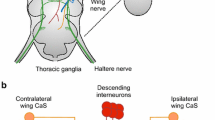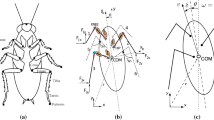Summary
The right fore wing of a tethered locust (Locusta migratoria) flying in front of a wind tunnel was moved up and down about its normal axis of rotation. The reaction of the animal was measured by recording muscle potentials from the depressor muscles of all wings.
The flight rhythm of an animal can be forced to take a preferred phase with regard to the input rhythm, provided the stimulating frequency does not differ by more than 10 to 15% from the wing beat frequency of the non-driven wings. The reaction is apparently due to phasic proprioceptive feedback from the driven wing which influences the flight rhythm within a few wing beats. This proprioceptive feedback normally increases the precision of co-ordination of the wings among themselves.
Zusammenfassung
Bei fixiert vor dem Windkanal fliegenden Heuschrecken (Locusta migratoria) wurde der rechte Vorderflügel mit Hilfe eines umgebauten Tintenschreibers um seine Drehachse zwangsbewegt. Als Reaktion des Tieres wurden Muskelpotentiale aus den direkten Senkern aller Flügel abgeleitet. Der so gemessene Flugrhythmus kann von der aufgezwungenen Vorderflügelbewegung in eine bevorzugte Phase gezwungen werden, sofern die Reizfrequenz nicht weiter als 10–15% von der Flügelschlagfrequenz abweicht. Es handelt sich hierbei um einen phasischen, koppelnden Einfluß auf den Flugrhythmus, der bereits innerhalb weniger Flügelschläge nach Einsetzen des Reizes sichtbar werden kann und von Propriozeptoren vermittelt wird, die die aktuelle Flügelbewegung messen. Die propriozeptiven Rückmeldungen erhöhen die Präzision der Koordination der 4 Flügel untereinander.
Similar content being viewed by others
References
Aschoff, J.: Response curves in circadian periodicity. From: Circadian clocks, p. 95–111. Amsterdam: North Holland Publishing Co. 1965
Bentley, D. R.: Intracellular activity in cricket neurons during generation of song patterns. Z. vergl. Physiol.62, 227–283 (1969)
Burrows, M.: The role of delayed excitation in the co-ordination of some metathoracic flight motoneurons of the locust. J. comp. Physiol.83, 135–164 (1973)
Camhi, J.: Locust wind receptors. III. Contributions to flight initiation and lift control. J. exp. Biol.50, 363–373 (1969)
Camhi, J.: Yaw-correcting postural changes in locusts. J. exp. Biol.52, 519–531 (1970)
Camhi, J.: Sensory control of abdomen posture in flying locusts. J. exp. Biol.52, 533–537 (1970)
Camhi, J., Hinkle, M.: Attentiveness to sensory stimuli: Central control in locusts. Science175, 550–553 (1972)
Gettrup, E.: Thoracic proprioceptors in the flight system of locusts. Nature (Lond.)193, 498–499 (1962)
Gettrup, E.: Phasic stimulation of a thoracic stretch receptor in locusts. J. exp. Biol.40, 323–333 (1963)
Gettrup, E.: Sensory regulation of wing twisting in locusts. J. exp. Biol.44, 1–16 (1966)
Gettrup, E., Wilson, D. M.: The lift-control reaction of flying locusts. J. exp. Biol.41, 183–190 (1964)
Gewecke, M.: Die Wirkung von Luftströmung auf die Antennen und das Flugverhalten der Blauen Schmeißfliege (Calliphora erythrocephala). Z. vergl. Physiol.54, 121–164 (1967)
Gewecke, M.: Antennae: Another wind-sensitive receptor in locusts. Nature (Lond.)225, 1263–1264 (1970)
Gewecke, M.: Der unterschiedliche Einfluß der Antennen und Stirnhaare vonLocusta migratoria auf die Fluggeschwindigkeit. Naturwissenschaften58, 101 (1971)
Gewecke, M.: Antennen und Stirn-Scheitelhaare vonLocusta migratoria L. als Luftströmungs-Sinnesorgane bei der Flugsteuerung. J. comp. Physiol.80, 57–94 (1972)
Gewecke, M.: Die Regelung der Fluggeschwindigkeit bei Heuschrecken und ihre Bedeutung für die Wanderflüge. Control of flying speed in locusts and its significance for their migrations. Verh.-Ber. Dtsch. Zool. Ges.65, 247–250 (1972)
Goodman, L. J.: The role of certain optomotor reactions in regulating stability in the rolling plane during flight in the desert locust,Schistocerca gregaria. J. exp. Biol.42, 385–407 (1965)
Heide, G.: Flugsteuerung durch nicht-fibrilläre Flugmuskeln bei der SchmeißfliegeCalliphora. Z. vergl. Physiol.59, 456–460 (1968)
Heide, G.: Die Funktion der nicht-fihrillären Flugmuskeln vonCalliphora. Teil II: Muskuläre Mechanismen der Flugsteuerung und ihre nervöse Kontrolle. Zool. Jb. Abt. allg. Zool. u. Physiol.76, 99–137 (1971)
Heran, H.: Wahrnehmung und Regelung der Flugeigengeschwindigkeit beiApis mellifica L. Z. vergl. Physiol.42, 103–163 (1959)
Heran, H., Lindauer, M.: Windkompensation und Seitenwindkorrektur der Bienen beim Flug über Wasser. Z. vergl. Physiol.47, 39–55 (1963)
Hoffmann, K.: Die relative Wirksamkeit von Zeitgebern. Oecologia (Berl.)3, 184–206 (1969)
Holst, E. v.: Die relative Koordination als Phänomen und als Methode zentralnervöser Funktionsanalyse. Ergebn. Physiol.42, 228–306 (1939)
Huber, F.: Nervöse Grundlagen der akustischen Kommunikation bei Insekten. Rheinisch-Westfälische Akademie der Wissenschaften. Vorträge N205, 41–91. Opladen: Westdeutscher Verlag 1970
Huber, F.: Principles of motor co-ordination in cyclically recurring behaviour in insects. In press 1973
Kutsch, W.: Unpublished. Personal communication 1973
Mittelstaedt, H.: Physiologie des Gleichgewichtssinnes bei fliegenden Libellen. Z. vergl. Physiol.32, 422–463 (1950)
Pabst, H.: Elektrophysiologische Untersuchung des Streckrezeptors am Flügelgelenk der WanderheuschreckeLocusta migratoria. Z. vergl. Physiol.50, 498–541 (1951)
Pringle, J. W. S.: Insect flight. Cambridge: The university Press 1957
Pringle, J. W. S.: Flight. In: The physiology of insecta, ed. Rockstein, vol. 2. New York-London: Academic Press 1965
Waldron, J.: The mechanism of coupling of the locust flight oscillator to oscillatory inputs. Z. vergl. Physiol.57, 331–347 (1968)
Weis-Fogh, T.: An aerodynamic sense organ stimulating and regulating flight in locusts. Nature (Lond.)164, 873–874 (1949)
Weis-Fogh, T.: Biology and physics of locust flight. II. Flight performance of the desert locust (Schistocerca gregaria). Phil. Trans. B239, 459–510 (1956)
Weis-Fogh, T.: Biology and physics of locust flight. IV. Notes on sensory mechanisms in locust flight. Phil. Trans. B239, 553–584 (1956)
Wendler, G.: Über den Anteil der Antennen an der Schwererezeption der StabheuschreckeCarausius morosus. Z. vergl. Physiol.51, 60–66 (1965)
Wendler, G.: The co-ordination of walking movements in arthropods. Symp. Soc. exp. Biol.20, 229–249 (1965)
Wendler, G.: Körperhaltung bei der Stabheuschrecke: ihre Beziehung zur Schwereorientierung und Mechanismen ihrer Regelung. Posture in insects: its relevance to gravity orientation and mechanisms for its control. Verh.-Ber. Dtsch. Zool. Ges.65, 214–219 (1972)
Wendler, G., Heiligenberg, W.: Relative Koordination bei gekoppelten, rhythmisch tätigen Modellneuronen. Zool. Anz., Suppl.33, 477–482, Verh. Zool. Ges. 1969
Wever, R.: Possibilities of phase control, demonstrated by an electronic model. Cold Spr. Harb. Symp. quant. Biol.25, 197–206 (1960)
Wilson, D.M.: The central nervous control of flight in a locust. J. exp. Biol.38, 471–490 (1961)
Wilson, D.M.: Proprioceptive leg reflexes in cockroaches. J. exp. Biol.43, 397–409 (1965)
Wilson, D.M.: An approach to the problem of control of rhythmic behavior. From: Invertebrate nervous systems, ed. C.A.G. Wiersma, p. 219–229. Chigaco-London: Chicago Univ. Press 1967
Wilson, D.M., Gettrup, E.: A stretch reflex controlling wingbeat frequency in grashoppers. J. exp. Biol.40, 171–185 (1963)
Wilson, D.M., Weis-Fogh, T.: Patterned activity of co-ordinated motor units, studied in flying locusts. J. exp. Biol.39, 643–667 (1962)
Wilson, D.M., Wyman, R. J.: Motor output patterns during random and rhythmic stimulation of locust thoracic ganglia. Biophys. J.5, 121–143 (1965)
Author information
Authors and Affiliations
Additional information
I wish to thank Frau L. Dinnendahl for technical assistance with drafting, and Drs. H. Howland, R. Fernald, H. Mittelstaedt, and H. Scharstein for their helpful readings of the manuscript.
Rights and permissions
About this article
Cite this article
Wendler, G. The influence of proprioceptive feedback on Locust flight co-ordination. J. Comp. Physiol. 88, 173–200 (1974). https://doi.org/10.1007/BF00695406
Received:
Issue Date:
DOI: https://doi.org/10.1007/BF00695406




